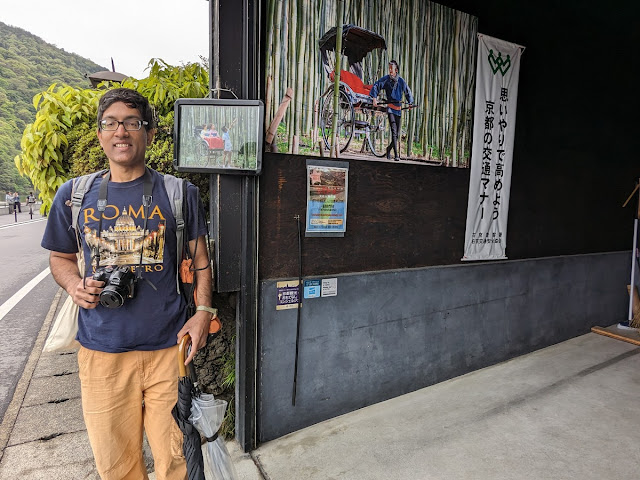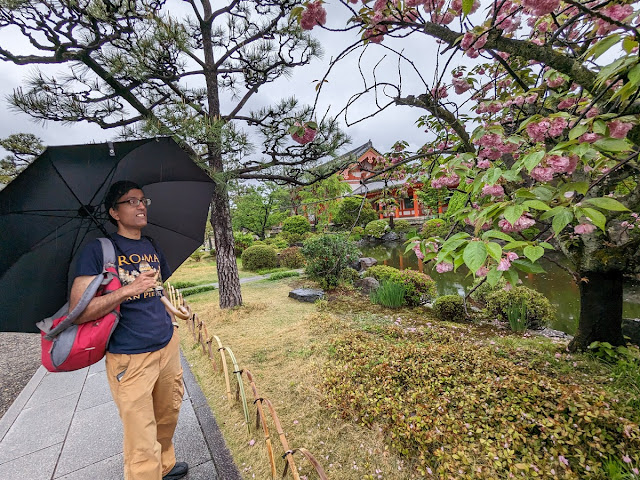DAY 10, Apr 21 Sun 2024:
Kyoto Arashiyama, Togetsu-kyo bridge, Bamboo grove, Hōgon-in, Tenryū-ji, Kōgen-ji Temple, Sanjūsangen-dō
Arashiyama is a scenic district in the outskirts of Kyoto
Arashiyama (嵐山, Storm Mountain) is a mountain across the Ōi River (大堰川, Ōi-gawa), which forms a backdrop to the district also called Arashiyama. It is a nationally designated Historic Site and Place of Scenic Beauty.
We took bus #28 from the Kyoto station terminal and got down at Arashiyama koen, landed near the iconic river bridge, it was a 200m, 2 min walk
The bus had taken 45 minutes. if we had taken the local train and got down at the saga Arashiyama Station it would have been a 30 minute train journey but the walk to the bridge would have been a km taking some 12 minutes, so we chose the bus
The "Moon Crossing Bridge" (渡月橋, Togetsukyō)
It was originally built during the Heian Period (794-1185) and most recently reconstructed in the 1930s.
Pedicabs are a tourist attraction
Hōgon-in
We bought a combo ticket for 2 temples Kōgen-ji and Hogon-in.
Hogon-in Temple in Arashiyama, is a Buddhist sub-temple of the Rinzai Zen head temple, Tenryu-ji.
The temple was founded in 1461
Fusuma
fusuma (襖) are sliding panels traditionally painted. There was a special fee to see these.

The garden is lovely... more special in fall of course

Arashiyama Rakans
Statues of Disciples of Buddha are in the garden and just outside as well... all with different postures and expressions.
Buddha's disciples statues...Go-hyaku Rakan
Statues of 500 most devoted disciples of Buddha, stand near Tenryu-ji Temple at Arashiyama
Kōgen-ji
Kōgen-ji TempleBoth these ice creams were terrible...mocha was bitter, vanilla bland. It was just a good place to sit till the drizzle abated
BAMBOO GROVE:
Straight bamboo grows like a tunnel for approx. 100 meters from the north of the Tenryuji Temple. Pretty sight, we could not take better pics because of a constant drizzle
there are toriis [sacred gates] and shrines
Wisteria
We took the bus back and we talked to the driver, he suggested us to get down at a particular station, and take the local train to Kyoto Station because that would be faster for us.
He gestured us to get down and the train station was right across the road from that bus stop.
We did so, it was just 17 min train ride and we reached Kyoto Station. From there we took bus #206 [9 minutes, 4 stops]and reached Sanjūsangen-dō
Sanjūsangen-dō (三十三間堂, Temple of thirty-three bays)officially known as Rengeō-in (蓮華王院, hall of the Lotus King)
A temple built by the famous warlord Taira no Kiyomori for Emperor Go-Shirakawa in 1164, Sanjūsangen-dō is primarily famous for its 1,001 statues of Kannon, the goddess of compassion in her thousand-armed incarnation, lined up along the entire length of the thirty-three ken (unit of measurement) hall from which the temple gets its moniker.
The temple complex used to be larger until a fire decimated it and only the main hall was rebuilt, but visitors are more than satisfied with the impressive contents of the long wooden structure. Not only is the hall filled with the golden faces of a thousand Kannon statues, but another 28 sculptures of Buddhist guardian deities are also featured in the front row.
The hall itself shows its age in the many arrow notches that can be found in the wood on the edge of the building, marks of the Tōshiya archery competition once held at the temple hundreds of years ago.
Arranged in ten rows and fifty columns on each side of the hall, the thousand statues of Kannon are made of Japanese cypress covered in gold leaf.
Of these, 124 are originals from the temple’s founding that were saved from destruction in a 1249 fire, while the rest were replaced in the 13th century.
We took a bus back to our apt.

























































































No comments:
Post a Comment